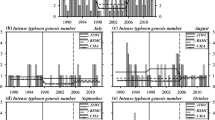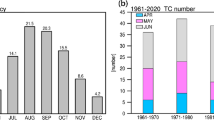Abstract
The effects of the El Niño-Southern Oscillation (ENSO) phase and the shifting of the ENSO sea surface temperature (SST) on the intensity of tropical cyclones (TC) have been extensively investigated in terms of TC genesis locations in the western North Pacific (WNP). To advance the hypothesis for a relation of genesis location–intensity that the TC formation location hints its intensity, two cases have been compared, which include the phase of the decaying El Niño turning over to La Niña (type I) and the phase that recovers to a neutral condition (type II). In addition, the shift of ENSO SST to the central Pacific warming (CPW) from the East Pacific warming (EPW) has been examined. The genesis potential index (GPI) and the accumulated cyclone energy have been applied to compare the differences between the ENSO phase and the TC formation location. It was apparent that ENSO influences the WNP typhoon formation location depending on the cycle of the ENSO phase. In addition, the typhoon activity was affected by the zonal shift of the El Niño SST. The CPW, which has maximum SST over the central Pacific, tends to have a persistently high GPI over the WNP in September–November and June–August, demonstrating that the formation locations of strong TCs significantly shift southeastward compared with the EPW having SST maximum over the eastern Pacific. CPW years revealed a distinguishable relationship between the TC formation location and the TC between the tropical depression (TD) + tropical storm (TS) and the intense typhoon of category 4 + 5.











Similar content being viewed by others
References
Ashok K, Behera SK, Rao SA, Weng H, Yamagata T (2007) El Niño Modoki and its possible teleconnection. J Geophys Res 112:C11007. doi:10.1029/2006JC003798
Bell GD, Halpert MS, Kousky VE, Gelman ME, Ropelewski CF, Douglas AV, Schnell RS (2000) Climate assessment for 1999. Bull Am Meteorol Soc 81:S1–S50
Bjerknes J (1966) A possible response of the atmospheric Hadley circulation to equatorial anomalies of ocean temperature. Tellus 18:820–829
Camargo SJ, Sobel AH (2005) Western North Pacific tropical cyclone intensity and ENSO. J Clim 18:2996–3006
Camargo SJ, Emanuel KA, Sobel AH (2007) Use of a genesis potential index to diagnose ENSO effects on tropical cyclone genesis. J Clim 20:4819–4834
Chan JCL (2000) Tropical cyclone activity over the western North Pacific associated with El Niño and La Niña events. J Clim 13:2960–2972
Chan JCL, Xu J (2000) Physical mechanisms responsible for the transition from a warm to a cold state of the El Niño/Southern Oscillation. J Clim 13:2056–2071
Chen G, Tam CY (2010) Different impacts of two kinds of Pacific Ocean warming on tropical cyclone frequency over the western North Pacific. Geophys Res Lett 37:L01803. doi:10.1029/2009GL041708
Chen TC, Weng SP, Yamazaki N, Kiehne S (1998) Interannual variation in the tropical cyclone activity over the western North Pacific. Mon Wea Rev 126:1080–1090
Clark JD, Chu P (2002) Interannual variation of tropical cyclone activity over the central North Pacific. J Meteorol Soc Jpn 80:403–418
Emanuel KA (1995) Sensitivity of tropical cyclones to surface exchange coefficients and a revised steady-state model incorporating eye dynamics. J Atmos Sci 52:3969–3976
Emanuel KA, Nolan DS (2004) Tropical cyclone activity and the global climate system. Preprints, 26th Conference on Hurricanes and Tropical Meteorology, Miami, FL, American Meteorological Society, pp 240–241
Evans JL (1993) Sensitivity of tropical cyclone intensity to sea surface temperature. J Clim 6:1133–1140
Gray WM (1984) Atlantic seasonal hurricane frequency. Part 1: El Niño and 30 mb quasi-biennial oscillation influences. Mon Wea Rev 112:1649–1668
Ha K-J, Lee S-S (2007) On the interannual variability of the Bonin high associated with the East Asian summer monsoon rain. Clim Dyn 28:67–83
Hastings PA (1990) Southern Oscillation influences on tropical cyclone activity in the Australian/South-west Pacific region. Int J Climat 10:291–298
Jang S-R, Ha K-J (2008) On the relationship between typhoon intensity and formation region: effect of developing and decaying ENSO. J Korean Earth Sci Soc 29:29–44
Kao H-Y, Yu J-Y (2008) Contrasting eastern-Pacific and central-Pacific types of ENSO. J Clim 22:615–632
Kim H-M, Webster PJ, Curry JA (2009) Impact of shifting patterns of Pacific Ocean warming on North Atlantic tropical cyclones. Science 325:77–80
Kim H-M, Webster PJ, Curry JA (2011) Modulation of North Pacific tropical cyclone activity by three phases of ENSO. J Clim 24:1839–1849
Kug J-S, Kang I-S (2006) Interactive feedback between the Indian Ocean and ENSO. J Clim 19:1784–1801
Kug J-S, Kirtman BP, Kang IS (2006) Interactive feedback between ENSO and the Indian Ocean in an interactive coupled model. J Clim 19:6371–6381
Kug J-S, Jin FF, An S-I (2009) Two types of El Niño events: cold tongue El Niño and warm pool El Niño. J Clim 22:1499–1515
Lee S-S, Vinayachandran PN, Ha K-J, Jhun J-G (2010) Shift of peak in summer monsoon rainfall over Korea and its association with El Niño–Southern Oscillation. J Geophys Res 115:D02111. doi:10.1029/2009JD011717
Lindzen RS, Nigam S (1987) On the role of sea surface temperature gradients in forcing low-level winds and convergence in the tropics. J Atmos Sci 44:2418–2436
Murakami H, Wang B, Kitoh A (2010) Future change of western North Pacific typhoons: projections by a 20-km-mesh global atmospheric model. J Clim 24:1154–1169. doi:10.1175/2010JCLI3723.1
Rasmusson EM, Carpenter TH (1982) Variations in tropical sea surface temperature and surface wind fields associated with Southern Oscillation/El Niño. Mon Wea Rev 110:354–384
Wang B, Chan JCL (2002) How strong ENSO events affect tropical storm activity over the Western North Pacific. J Clim 15:1643–1658
Wu B, Li T, Zhou T (2010) Relative contributions of the Indian Ocean and local SST anomalies to the maintenance of the western North Pacific anomalous anticyclone during El Niño decaying summer. J Clim 23:2974–2986
Xie SP, Hu K, Hafner J, Tokinaga H, Du Y, Huang G, Sampe T (2009) Indian Ocean capacitor effect on Indo-western Pacific climate during the summer following El Niño. J Clim 22:730–747
Xu J, Chan JCL (2001) The role of the Asian/Australian monsoon system in the onset time of El Niño events. J Clim 14:418–433
Yeh S-W, Kug J-S, Dewitte B, Kwon M-H, Kirtman BP, Jin FF (2009) El Niño in a changing climate. Nature 461:511–514
Zhou T, Yu R, Zhang J, Drange H, Cassou C, Deser C, Hodson DLR, Sanchez-Gomez E, Li J, Keenlyside N, Xin X, Okumura Y (2009) Why the western Pacific subtropical high has extended westward since the late 1970s. J Clim 22:2199–2215
Acknowledgments
This work was supported by the National Research Foundation of Korea (NRF) grant funded by the Korea government (MEST, no. 2011-0021927). J.-S. Kug is partly supported by KORDI (PE98801, PE98563).
Author information
Authors and Affiliations
Corresponding author
Rights and permissions
About this article
Cite this article
Ha, KJ., Yoon, SJ., Yun, KS. et al. Dependency of typhoon intensity and genesis locations on El Niño phase and SST shift over the western North Pacific. Theor Appl Climatol 109, 383–395 (2012). https://doi.org/10.1007/s00704-012-0588-z
Received:
Accepted:
Published:
Issue Date:
DOI: https://doi.org/10.1007/s00704-012-0588-z




